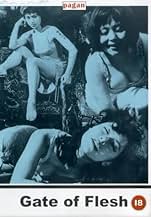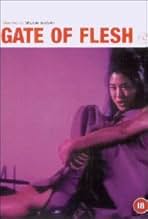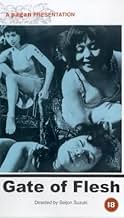CALIFICACIÓN DE IMDb
7.2/10
3.6 k
TU CALIFICACIÓN
Un ladrón herido que huye encuentra refugio en un burdel de mujeres unidas y despiadadas.Un ladrón herido que huye encuentra refugio en un burdel de mujeres unidas y despiadadas.Un ladrón herido que huye encuentra refugio en un burdel de mujeres unidas y despiadadas.
Jô Shishido
- Shintaro Ibuki
- (as Joe Shishido)
Chico Lourant
- Black Pastor
- (as Chico Roland)
- Dirección
- Guionistas
- Todo el elenco y el equipo
- Producción, taquilla y más en IMDbPro
Opiniones destacadas
This film proves that good directors are able to make first-rate films in spite of very modest budgets if they have the desire and creativity necessary to succeed. Essentially, this movie concerns the plight of a small number of prostitutes who are trying to survive in post-World War II Tokyo during the American occupation. With food, medicine, shelter and employment in scarce supply those without any resources became like animals just trying to stay alive. So 5 or 6 young prostitutes take refuge in a bombed out basement and agree to live by a very strict code which forbids, among other things, sex without payment. Those who fail to comply are tortured and then thrown back onto the cold streets without any means of protection or support. At any rate, things are going well for this small group until a war-weary Japanese soldier arrives suffering from a gunshot wound. Now, rather than giving away the entire plot I will just say that the director, Seijun Suzuki, uses various techniques (like different colors to differentiate the women) to create something quite impressive out of almost nothing. Just be advised that there is some nudity and violence that wasn't usual for this period in time. But even here he uses symbolism in many cases so that it doesn't seem crass or vulgar. In short, this is a picture that I recommend to those who can appreciate artistry and ingenuity and don't depend on special effects and CGI for their film entertainment. But it's not for the squeamish.
10zetes
I was under the impression when I rented this film that it was
directed by Sezuki Seijun, but the credits gave a different name. It
still might be him (it was something else Sezuki), and I am
assuming it was as I write this review.
Having totally fallen in love with Branded to Kill and, to a slightly
lesser extant, but not too much lesser, with Tokyo Drifter, I was
overjoyed to find this at the video store (I remembered having
heard at one point of its being on video). And I was even more
overjoyed to watch it. It's an amazing film which I would place
slightly ahead of Tokyo Drifter and Branded to Kill, giving it a 9/10.
The film opens right after the end of WWII with a young woman
starving in the street (not something I would expect from the two
previous yakuza films I've seen of Seijun's). She meets up with a
group of four prostitutes who allow her to work with them. They are
self-sufficient and need no pimp. They keep themselves in line
with the threat of torture if any one of them ever sleeps with a man
without accepting money. Of course, you can see the possibility for
exploitation, and there is exploitation, believe me. After a while, a
robust thug (Jo Shishido of Branded to Kill, cheekbones and all)
shows up in their crumbling household. They respect him
because he resists the GIs who try to keep the law in their city
(never specified) and those Japanese people who cooperate with
them. They're also all attracted to him. After this is developed, there
isn't much more plot - only a couple of events happen afterwards.
More or less, it is a character study and also a sociological study.
The anti-Americanism is very interesting to see. Seijun was a
soldier in the Japanese army himself and, although I could easily
point out that, hey, you started it, it's easy to understand what he
must have felt after he and his comrades lost a war, what it would
have done to the male psyche as well as the female (this film was
made about twenty years afterwards).
Some people would naturally hate this film because it mixes its
styles, often very harshly. It's really nothing that Godard wouldn't
have done - in fact, it's actually something that Godard, despite my
great affection for him and his films, could never have achieved; he
was far too interested in subverting filmic conventions and too
unconcerned with making interesting films at times. It is filmed in
color, and its art design/cinematography/costuming, everything
technical, is color coordinated in a way akin to something like a
1950s musical. Four of the five prostitutes are color-coated and
there is, for instance, an amazing scene where these four color- specific hookers muse over Shishido alone against a set
designed only in their colors. Often the film is quite melodramatic,
almost like a Douglas Sirk film. At other times, it is something like
sado-masochistic porno, especially during the torture scenes.
There are scenes akin to the brutality in Tokyo Drifter and Branded
to Kill; there is some major brutality to women (sometimes
inflicted by women), so if you're particularly sensitive to that, you
might want to avoid this. Also, if that's a problem with you, take
special measures to avoid Branded to Kill. You might want to skip
over this next description tot he next paragraph if you very easily get
sick or if you're a militant animal rights activist, but there is a
stunning scene where Jo Shishido slaughters a live cow. I'm pretty
sure it's a real scene of slaughter. If not, then it's a damned good
facsimile. If you were horrified at the real scenes of sacrifice in
Apocalypse Now, you might just want to avoid this film altogether.
The bottom line for me is that this film is a masterpiece. An insane
one, to be sure, but this film, as well as Tokyo Drifter and Branded
to Kill, demonstrate just how gorgeous insanity can be
sometimes. Janus Films, whose logo you see on the videotapes
before just about 90% of all foreign films that were made before
1970, and Home Vision Cinema, who distributes about everything
made after 1970, collaborated on the videotape that I watched,
which recently went out of print. Those two companies should be
ringing tons of bells for anyone who collects videos. Yup, those are
the two companies who produce DVDs' (and Laserdiscs') Criterion Collection, the only DVDs, in the long run, which are really
worth owning. This company has already released both Branded
to Kill and Tokyo Drifter. I pray to God - I'd even sell my soul to the
devil - so that Criterion will release Gate of Flesh and - please,
please God! (or Satan!) - other Seijun films, or even other films
which generally resemble his, if such other artists do exist, that I
have not seen or even heard of. Think about it Criterion. I know that
Branded to Kill and Tokyo Drifter aren't your most popular DVDs,
but, having talked to so many people who are discovering them
and having never resisted an opportunity to spread his name and
reputation to any other film buff I have met (and others who are
familiar with him do the same), I know that he is becoming a huge
cult item. In my mind, judging only by the three films of his that I've
seen, I prefer him even to Akira Kurosawa (I cannot comment on
Ozu or Mizoguchi; unfortunately, I have only ever seen one Ozu and
no Mizoguchis, merely based on availability), whom I generally
prefer to nearly every filmmaker with whom I am very familiar.
directed by Sezuki Seijun, but the credits gave a different name. It
still might be him (it was something else Sezuki), and I am
assuming it was as I write this review.
Having totally fallen in love with Branded to Kill and, to a slightly
lesser extant, but not too much lesser, with Tokyo Drifter, I was
overjoyed to find this at the video store (I remembered having
heard at one point of its being on video). And I was even more
overjoyed to watch it. It's an amazing film which I would place
slightly ahead of Tokyo Drifter and Branded to Kill, giving it a 9/10.
The film opens right after the end of WWII with a young woman
starving in the street (not something I would expect from the two
previous yakuza films I've seen of Seijun's). She meets up with a
group of four prostitutes who allow her to work with them. They are
self-sufficient and need no pimp. They keep themselves in line
with the threat of torture if any one of them ever sleeps with a man
without accepting money. Of course, you can see the possibility for
exploitation, and there is exploitation, believe me. After a while, a
robust thug (Jo Shishido of Branded to Kill, cheekbones and all)
shows up in their crumbling household. They respect him
because he resists the GIs who try to keep the law in their city
(never specified) and those Japanese people who cooperate with
them. They're also all attracted to him. After this is developed, there
isn't much more plot - only a couple of events happen afterwards.
More or less, it is a character study and also a sociological study.
The anti-Americanism is very interesting to see. Seijun was a
soldier in the Japanese army himself and, although I could easily
point out that, hey, you started it, it's easy to understand what he
must have felt after he and his comrades lost a war, what it would
have done to the male psyche as well as the female (this film was
made about twenty years afterwards).
Some people would naturally hate this film because it mixes its
styles, often very harshly. It's really nothing that Godard wouldn't
have done - in fact, it's actually something that Godard, despite my
great affection for him and his films, could never have achieved; he
was far too interested in subverting filmic conventions and too
unconcerned with making interesting films at times. It is filmed in
color, and its art design/cinematography/costuming, everything
technical, is color coordinated in a way akin to something like a
1950s musical. Four of the five prostitutes are color-coated and
there is, for instance, an amazing scene where these four color- specific hookers muse over Shishido alone against a set
designed only in their colors. Often the film is quite melodramatic,
almost like a Douglas Sirk film. At other times, it is something like
sado-masochistic porno, especially during the torture scenes.
There are scenes akin to the brutality in Tokyo Drifter and Branded
to Kill; there is some major brutality to women (sometimes
inflicted by women), so if you're particularly sensitive to that, you
might want to avoid this. Also, if that's a problem with you, take
special measures to avoid Branded to Kill. You might want to skip
over this next description tot he next paragraph if you very easily get
sick or if you're a militant animal rights activist, but there is a
stunning scene where Jo Shishido slaughters a live cow. I'm pretty
sure it's a real scene of slaughter. If not, then it's a damned good
facsimile. If you were horrified at the real scenes of sacrifice in
Apocalypse Now, you might just want to avoid this film altogether.
The bottom line for me is that this film is a masterpiece. An insane
one, to be sure, but this film, as well as Tokyo Drifter and Branded
to Kill, demonstrate just how gorgeous insanity can be
sometimes. Janus Films, whose logo you see on the videotapes
before just about 90% of all foreign films that were made before
1970, and Home Vision Cinema, who distributes about everything
made after 1970, collaborated on the videotape that I watched,
which recently went out of print. Those two companies should be
ringing tons of bells for anyone who collects videos. Yup, those are
the two companies who produce DVDs' (and Laserdiscs') Criterion Collection, the only DVDs, in the long run, which are really
worth owning. This company has already released both Branded
to Kill and Tokyo Drifter. I pray to God - I'd even sell my soul to the
devil - so that Criterion will release Gate of Flesh and - please,
please God! (or Satan!) - other Seijun films, or even other films
which generally resemble his, if such other artists do exist, that I
have not seen or even heard of. Think about it Criterion. I know that
Branded to Kill and Tokyo Drifter aren't your most popular DVDs,
but, having talked to so many people who are discovering them
and having never resisted an opportunity to spread his name and
reputation to any other film buff I have met (and others who are
familiar with him do the same), I know that he is becoming a huge
cult item. In my mind, judging only by the three films of his that I've
seen, I prefer him even to Akira Kurosawa (I cannot comment on
Ozu or Mizoguchi; unfortunately, I have only ever seen one Ozu and
no Mizoguchis, merely based on availability), whom I generally
prefer to nearly every filmmaker with whom I am very familiar.
Having discovered the Female Prisoner Scorpion series recently, I've been looking out for more Japanese exploitation films and Gates of Flesh is an early example. The film is a bit artier than the other examples I've seen, and despite focuses on a nest of prostitutes; there isn't a lot of sex/nudity in it either. However, director Seijun Suzuki gets round this by giving the film a tremendously dark and unpleasant atmosphere that bodes well with the plot line as well as the time in which the film is set. The film is set shortly after World War II and we focus on a group of prostitutes who have come together to work for themselves. As a result, they have no pimp to answer to and so have to protect themselves also. They get a strict set of rules in place, which are enforced again by the girls themselves and the main rule states that none of them may give out what they sell for free. The group gets a new member in the form of a girl named Maya and shortly afterwards a thief seeks sanctuary with the prostitutes, and causes disruption within the group.
The plot is very ambiguous and it's never made clear exactly what the 'point' of any of the characters is, which on the one hand makes the film interesting as it means we have to work things out for ourselves; but on the other, the characters lack humanity and so the film can be a bit dry as a result. The director is apparently quite respected for making films like this; Gate of Flesh is the first one of his that I've seen so I cant comment on the body of his work, but clearly he is a director that values of the importance of making his films interesting and Gate of Flesh also looks very nice and the director gets the best out of his performers. I think that the director was hoping more to get a point across than anything else, but he also values style and that comes across well in the film also. The plot does flow fairly well, although at times it seems like there's not a lot happening so the film is not constantly entertaining. Overall, I won't name this film as a favourite of mine and I do prefer the more wild Japanese exploitation flicks; but this certainly isn't a bad film and I can recommend it.
The plot is very ambiguous and it's never made clear exactly what the 'point' of any of the characters is, which on the one hand makes the film interesting as it means we have to work things out for ourselves; but on the other, the characters lack humanity and so the film can be a bit dry as a result. The director is apparently quite respected for making films like this; Gate of Flesh is the first one of his that I've seen so I cant comment on the body of his work, but clearly he is a director that values of the importance of making his films interesting and Gate of Flesh also looks very nice and the director gets the best out of his performers. I think that the director was hoping more to get a point across than anything else, but he also values style and that comes across well in the film also. The plot does flow fairly well, although at times it seems like there's not a lot happening so the film is not constantly entertaining. Overall, I won't name this film as a favourite of mine and I do prefer the more wild Japanese exploitation flicks; but this certainly isn't a bad film and I can recommend it.
An exploitation film with a brain. We see nude women tastefully lit, kinky violence - women beating other women and the low life of Tokyo outdoing each other in even more dastardly acts of treachery and heartless thuggery. The intelligence comes with the strong impact of the women dressing in vibrant red, purple, yellow and green to reflect their characters. Having the prostitutes live in a building that is an analogy for post-war Japan is even smarter. The building is bombed out, its occupants desperate, many have lost family in the war and for some the sight of people burned to death has made them individually heartless, desperate and mad. The fact that most of them live in the basement indicates that they have plummeted into the depths of hell. For cinema goers in Japan in 1964, just enjoying the fruits of the boom years for their rebuilt economy and also a new found pride and respectability, this must have been a sobering but also satisfying reminder of where they had been and how far they had come.
Suzuki is the master! He has made the greatest examples of 60's low budget exploitation cinema. The way he uses a different color to represent each of the prostitutes almost makes them appear like demons in that underground lair of theirs. But who is the real monster of the film? The occupying Americans who use the prostitutes? The prostitutes themselves? Or is it the hate filled ex-soldier (played by the great Joe Shishido!) who controls the women?
¿Sabías que…?
- TriviaIn an interview Seijun answered the question of the uniqueness of this film in relation to other B/Program pictures he made in the time: "The studio wanted to make a skin flick, that's all. We couldn't make a real porno back then, though."
- ErroresA downward shot pans across a crowd following a stretcher. When straight down, you see the shadow of the camera, crane and the camera operator.
- ConexionesFeatured in From the Ruins: Making 'Gate of Flesh' (2005)
Selecciones populares
Inicia sesión para calificar y agrega a la lista de videos para obtener recomendaciones personalizadas
- How long is Gate of Flesh?Con tecnología de Alexa
Detalles
- Fecha de lanzamiento
- País de origen
- Idiomas
- También se conoce como
- Nakito - Profis der Liebe
- Locaciones de filmación
- Nikkatsu Studios, Tokio, Japón(Studio)
- Productora
- Ver más créditos de la compañía en IMDbPro
- Tiempo de ejecución1 hora 30 minutos
- Mezcla de sonido
- Relación de aspecto
- 2.35 : 1
Contribuir a esta página
Sugiere una edición o agrega el contenido que falta












